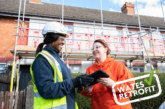
Following the decarbonisation of heat being put back on the agenda last year with the launch of the Government’s Clean Growth Strategy, Neil Schofield, Head of Government Affairs at Worcester, Bosch Group, explains what it might mean for homes within the social housing sector.

The Clean Growth Strategy set out proposals for decarbonising all sectors of the UK economy through the 2020s, and formed a welcome contribution to the debate about the country’s long-term energy strategy. Whilst it’s important to treat this kind of document with a certain amount of caution until the details have been fleshed out, there are some lessons that specifiers can take — particularly when it comes to how the future of heating might be affected.
Welcoming the use of hydrogen
That all options are still on the table when it comes to the decarbonisation of the gas grid is one real positive of the strategy. One of these options would be to replace natural gas with hydrogen, either entirely or in a blend similar to the town gas that was used until the late 1960s. Again, it’s great to see that the Government is committing to further feasibility studies and research into the feasibility of this type of system, which mirrors a lot of the work already being undertaken by ourselves at Worcester, Bosch Group and others in the heating industry into developing hydrogen-powered boilers.
Heat in Buildings
The proposals also reference other policy changes, such as Heat in Buildings. This suggests further changes to the Building Regulations, including that combination boilers should have a minimum efficiency of 92% ErP, and be installed alongside a time and temperature control, as well as one of four additional measures: a flue gas heat recovery system, weather compensation, load compensation, or automation and optimisation controls. This will help tenants to stay warmer for cheaper by squeezing even more efficiency from already highly advanced appliances, but does add another layer to the specification process.
Achieving Band C
The strategy also proposes that all homes will be Band C for energy efficiency by 2035. This should not be too much of a surprise, given that private rented landlords have known for some time that they would have to bring their properties to Band E by 2018. Nevertheless, it’s another thing for specifiers to consider as they draw up long-term plans for their housing stock — not least because achieving a Band C efficiency rating in an older property is much easier on paper than it is in practice.
It’s much simpler to incorporate these measures within the design of a new property, which is why it’s fair to say failing to introduce zero carbon new-build homes in 2016 means we’re only just catching up on where we should have been already.
Off-grid homes
One question mark over the document is to what extent the Government intends to follow through with the call to ‘take further action’ on off-grid homes currently using oil for heating. There details are sketchy, but any move to phase out oil would require very careful handling. For starters, oil is a significantly cheaper heating option than electricity (3.46p/kWh compared to 14.37p/kWh, according to the National Energy Trust). To compound the problem, the majority of our off-grid homes are old, poorly-insulated buildings, which are very badly suited to electric heating.
With many social housing properties situated in rural areas, not only could mandatory electric heat pumps leave off-grid tenants faced with a very significant rise in their energy bills, but we may even find ourselves using more carbon through a poorly performing heat pump run from fossil fuelled electricity.








